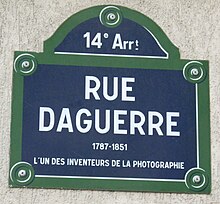| Daguerréotypes | |
|---|---|
 | |
| Directed by | Agnès Varda |
| Starring | Agnès Varda Rosalie Varda Mystag the Magician |
| Cinematography | Nurith Aviv |
| Edited by | Andrée Choty Gordon Swire |
| Distributed by | ZDF |
| Release date |
|
| Running time | 80 minutes |
| Country | France |
| Language | French |
Daguerréotypes is a 1976 French documentary by Agnès Varda. It features vignettes of life in Rue Daguerre - a street in Paris, where the filmmaker lived.
Varda was caring for her two-year-old son at the time of filming and could not spend long periods away from her home. Because of this, the entire film is confined within a 90 metres (300 ft) radius of Varda's home - the length of the electric cables for her equipment.
Most of those profiled come from places outside Paris, or even France. Over the course of the film, every subject is asked the same three questions: "Where did you come from?", "When did you get here?", "Why did you come?".
The film's name is a complex pun: The street, Rue Daguerre, is named after Louis Daguerre, inventor of the Daguerreotypes method of photographic printing. During a voiceover in the film, Varda explains that the business owners and occupants of Rue Daguerre are her 'types', in reference to typologies both as the photographic style and practices of social classification that Varda was critical of. At various points the subjects assume formal, static pose as if in mid-19th century photo portraiture.
References
- "Seven Facets of Agnes Vada". Sight & Sound magazine. British Film Institute. 1 April 2019.
- Jesse, Cataldo (8 December 2011). "Review: Daguerreotypes". Slant Magazine.
- Rebecca J. DeRoo (24 October 2017). Agnes Varda Between Film, Photography, and Art. Univ of California Press. p. 188. ISBN 978-0-520-27940-7.
- Charles, Musser. "Varda, Daguerréotypes (1975), and Women Respond (1975)".
External links
| Agnès Varda | |
|---|---|
| Fiction films |
|
| Documentaries |
|
| Short films |
|
This article related to a French film of the 1970s is a stub. You can help Misplaced Pages by expanding it. |
This 1970s documentary film-related article is a stub. You can help Misplaced Pages by expanding it. |